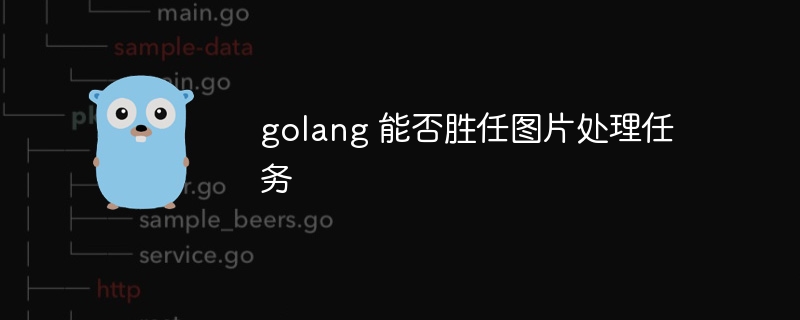

In today's Internet era, image processing has become an integral part of many applications. From social media platforms to e-commerce websites, image processing technology is widely used in image uploading, compression, cropping, filter processing and other functions. In the development process, choosing the appropriate programming language is also a crucial part. So, as a fast, efficient, statically typed programming language, can golang be qualified for these image processing tasks? This article will explore this issue through specific code examples.
First of all, let us take a look at golang's support for the image processing field. In the golang standard library, there is a package specifically for image processing called image. This package provides basic operations on images, such as creating, reading, writing, drawing and other functions. In addition, golang also has a more powerful image processing library, which is the image/draw package. This package provides more flexible and advanced image processing functions, including image scaling, cropping, rotation, mixing, etc.
Next, we use several specific code examples to show how golang handles image tasks.
package main
import (
"fmt"
"image"
"image/png"
"os"
)
func main() {
file, err := os.Open("example.png")
if err != nil {
fmt.Println("Error opening file:", err)
return
}
defer file.Close()
img, _, err := image.Decode(file)
if err != nil {
fmt.Println("Error decoding image:", err)
return
}
//Display image width and height
bounds := img.Bounds()
fmt.Println("Image width:", bounds.Dx())
fmt.Println("Image height:", bounds.Dy())
}The above code example demonstrates how to use golang to read and display the width and height information of an image. Read the image file through the image.Decode function, and then obtain the boundary information of the image through the Bounds() method, and then obtain the width and height information.
package main
import (
"fmt"
"image"
"image/jpeg"
"os"
)
func main() {
file, err := os.Open("example.jpg")
if err != nil {
fmt.Println("Error opening file:", err)
return
}
defer file.Close()
img, _, err := image.Decode(file)
if err != nil {
fmt.Println("Error decoding image:", err)
return
}
newWidth := 200
newHeight := 0
newImage := image.NewRGBA(image.Rect(0, 0, newWidth, newHeight))
draw.CatmullRom.Scale(newImage, newImage.Rect, img, img.Bounds(), draw.Src, nil)
outputFile, err := os.Create("resized.jpg")
if err != nil {
fmt.Println("Error creating output file:", err)
return
}
defer outputFile.Close()
jpeg.Encode(outputFile, newImage, nil)
fmt.Println("Image resized and saved as resized.jpg")
}The above code example shows how to use the image/draw package to scale an image to a specified width. By creating a new image.RGBA object, use the draw.CatmullRom method to scale the original image, and finally save the scaled image through the jpeg.Encode function picture.
package main
import (
"fmt"
"image"
"image/color"
"image/jpeg"
"os"
)
func main() {
file, err := os.Open("example.jpg")
if err != nil {
fmt.Println("Error opening file:", err)
return
}
defer file.Close()
img, _, err := image.Decode(file)
if err != nil {
fmt.Println("Error decoding image:", err)
return
}
bounds := img.Bounds()
newImage := image.NewRGBA(bounds)
filter := func(c color.Color) color.Color {
r, g, b, _ := c.RGBA()
gray := uint8((r*299 g*587 b*114 500) / 1000)
return color.Gray{Y: gray}
}
for y := bounds.Min.Y; y < bounds.Max.Y; y {
for x := bounds.Min.X; x < bounds.Max.X; x {
newImage.Set(x, y, filter(img.At(x, y)))
}
}
outputFile, err := os.Create("filtered.jpg")
if err != nil {
fmt.Println("Error creating output file:", err)
return
}
defer outputFile.Close()
jpeg.Encode(outputFile, newImage, nil)
fmt.Println("Image filtered and saved as filtered.jpg")
}以上代码示例展示了如何使用golang实现一种简单的图像滤镜效果,将彩色图片转换为灰度。通过定义一个filter函数,对每一个像素进行处理,最终生成一个灰度处理后的新图片,并保存为filtered.jpg文件。
通过以上几个示例,我们可以看到,golang在处理图像任务方面表现出色。通过标准库和image/draw包提供的功能,我们可以轻松实现图片的读取、缩放、滤镜处理等功能。因此,在选择编程语言时,如果对图像处理有需求,golang无疑是一个强有力的选择。
The above is the detailed content of Is golang capable of image processing tasks?. For more information, please follow other related articles on the PHP Chinese website!
 How to define variables in golang
How to define variables in golang
 What are the data conversion methods in golang?
What are the data conversion methods in golang?
 What are the commonly used libraries in golang?
What are the commonly used libraries in golang?
 What is the difference between golang and python
What is the difference between golang and python
 iPhone 16 expected launch time
iPhone 16 expected launch time
 Java environment variable configuration tutorial
Java environment variable configuration tutorial
 What does Taobao b2c mean?
What does Taobao b2c mean?
 pycharm installation tutorial
pycharm installation tutorial




